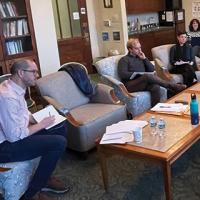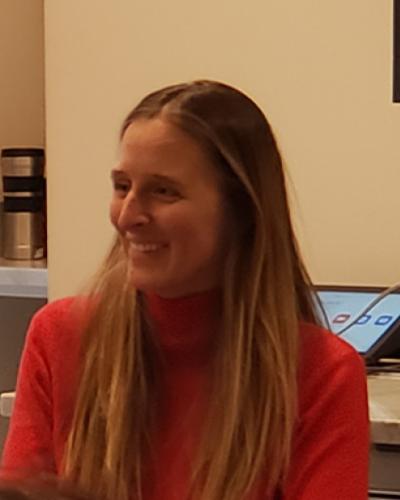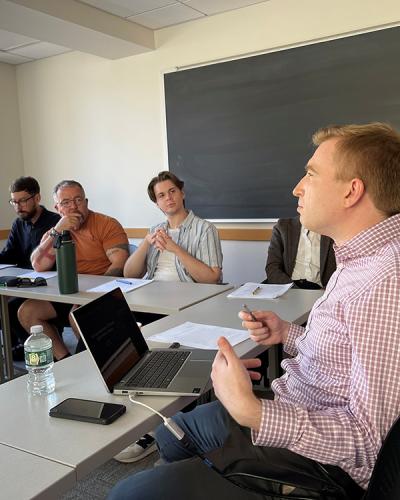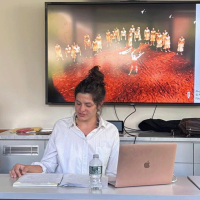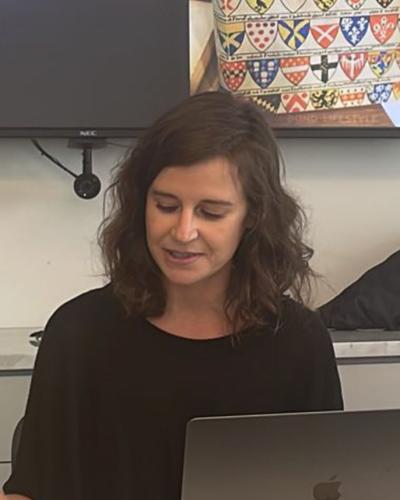Dr. Jenny Körber: "Irdischeund himmlische Verhältnisse: Ordnungen der Genealogie und Heraldik"
Friday, September 15, 2023 in Ithaca, New York
On September 15, 2023, Dr. Jenny Körber (University of Hamburg) presented her paper “Irdische und himmlische Verhältnisse. Ordnungen der Genealogie und Heraldik” in the IGCS Fall Colloquium Series. Dr. Körber, currently a postdoctoral researcher at the University of Hamburg, combines literary criticism and art history in her research. Her work centers on Jesuits, early modern media theory, and the intersection of religious art and literature.
Dr. Körber opened her presentation with a captivating reference to a James Bond movie, emphasizing the narrative's deployment of the widely recognized work of reference Boutell's Heraldry. She underscored the continued significance of coats of arms and heraldic signs in the 21st century due to their roles in conveying meaning and social order. Dr. Körber’s paper explored the theme of “worldly and heavenly relationships” within the context of genealogy and heraldry, focusing on modes of synergetic interaction in premodern media; the representation of different orders (Ordnungen); and their specific cognitive, aesthetic, and political functions.
In the introduction of her paper, Jenny Körber argued that orders are presented as dynamic, process-like, and pluralistic concepts that shape and influence societal spaces. They aim at fostering community; shaping perception; generating meaning; and facilitating knowledge. Focusing on heraldry and genealogy, Dr. Körber showed that they both significantly contributed to the symbolic order of society in the premodern era (and arguably well beyond) and are exhibited especially through intermedial synergies. Her study pursued an interdisciplinary media analysis of premodern genealogical and heraldic orders with an emphasis on analyzing visual and written artifacts and examining how various media collaborate to generate and transmit orders. The artifacts ranged from premodern written texts (armorials, textbooks, and handbooks) to visual art (ancestral or family trees, portraits) and the artistic arrangement of spaces (architecture, including fresco programs, windows, furniture, and the like). According to Körber, textbooks, armorials, and handbooks demonstrate the necessity of visual representations when it comes to genealogical information which may be listed in tabular form, depicted in diagrams, or represented by means of heraldic signs. She underlined that the materialities of the respective representations played a pivotal role as mediator between represented and remembered aspects. The connection of script and inscriptions with coats of arms illustrates the close relationship between genealogy and heraldry. It also highlights memorization as a form of meditation and access to knowledge.
Dr. Körber’s paper provided three concrete examples to illustrate how premodern media, especially in genealogy and heraldry, served to establish orders, convey knowledge, and connect the profane with the sacral.
(1) In Körber’s account, the triptych family tree of the Ritterfamilie Pfeffinger (1516) demonstrates how the triptych became detached from its exclusively liturgical function in the Middle Ages and premodern era and increasingly allowed for individuals, families, and communities to inscribe themselves into the Christian history of salvation. The triptych depicting the Ritterfamilie Pfeffinger displays references to the sacral as well as to the profane, blurring the line between them.
(2) Similarly, the armorial of the former Schänis Monastery (St. Gallen, Switzerland) served to establish a connection between worldly and spiritual duties. The women in the choir could trace their noble lineage and at the same time were reminded that they had sworn an oath, by dint of which they were bound to the secular responsibilities of their status for life.
(3) The genealogical and heraldic program of the City Residence Landshut served Dr. Körber as a most comprehensive and ambitious example of how heraldic orders may be represented in the architectural, artistic arrangement of representative spaces. The Landshut arrangement aims for a medial interplay creating genealogical memory spaces that involve the observing subject. Walking through the rooms, the observer encounters a wealth of images and illustrations and cannot help interpreting them and internalizing genealogical knowledge in the process. Thus with every walkthrough, the observer invokes and solidifies the continuity of the dynasty.
Questions raised in the lively discussion that followed Dr. Körber’s presentation included the nature of the audience for heraldic codification and whether such codification might serve as esoteric communication; the relationship between "Ordnung" (order) and "Form," and how social forms may be shaped by heraldry; the exploration of hidden relationships beyond families and dynasties that heraldry might reveal; the evolving concept of property and specific entitlements in relation to heraldic coats of arms; and the general significance and performative communal function of genealogy in the early modern.
Jenny Körber's thought-provoking exploration shed much light on the historical importance of genealogy and heraldry in the early modern era and their enduring relevance in contemporary society as dynamic forces shaping cultural orders and meanings.

